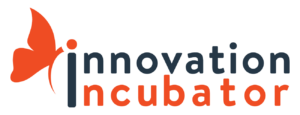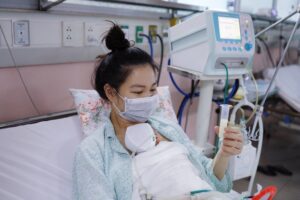
Human Milk Bank Service Network – Increase access to human donor milk for at risk newborns
Saving the lives of small and sick babies
The World Health Organization recommends pasteurized donor milk from a Human Milk Bank as the next option to breastmilk when a pre-term, sick, or low birth weight infant is unable to receive its mothers’ milk. A Human Milk Bank service network is an innovation to spread the protection of pasteurized donor milk to support optimal health outcomes and save infant lives.
A disruptive innovation – A new idea, model, product, or service in an existing market.
Alive & Thrive partners with the Ministry of Health, Maternal and Child Health Department in Viet Nam, and Provincial Departments of Health.
Challenging the Status Quo to Impact Nutrition
Q: What solution is offered by this innovation?
The establishment of a Human Milk Bank reduces the number of infants with severe illness and brings positive impacts on children’s health. While breastmilk is the optimal source of nutrition for all newborns, not all newborns can access their mothers’ own milk. The World Health Organization recommends donated breastmilk as the second-best infant feeding option, after mothers’ own milk, for at-risk babies, such as pre-term, low-birth-weight infants.
Human Milk Banks collect, pasteurize, test, and store breastmilk donated by volunteer lactating mothers who have passed a health screening. Subsequently, pasteurized donor human milk is distributed to infants following strict quality assurance procedures. At the same time, Human Milk Banks also provide lactation support for mothers to ensure that infants can access their own mothers’ milk as soon as possible, thereby increasing the prevalence breastfeeding during the hospital stays and in the community.
Large-scale investments in human and financial resources are required to both collect and distribute pasteurized donor milk in a safe way. Our Satellite Human Milk Bank model connects the main Human Milk Bank to neighbouring areas in a cold chain supply using monitoring software to facilitate transport, track and trace from raw breastmilk to pasteurized donor human milk between health facilities. Overall, the model is a three-step process: 1) screen and collect raw breast milk, 2) test, process and pasteurize raw breast milk, 3) manage and distribute pasteurized donor human milk.
Q: What is most exciting about the human milk bank?
Six pre-conditions are required to establish a Human Milk Bank or Satellite Human Milk Bank.
- The hospital must be designated as “Center of Excellence for Breastfeeding though Early Essential Newborn Care” by the Ministry of Health and WHO, including having an adequate number of beds to facilitate skin-to-skin contact. This helps ensure that optimal practices already exist and can be leveraged.
- Early initiation of breastfeeding rates must be sustained above 75% for both vaginal and caeserean deliveries.
- Breastfeeding promotion must occur consistently throughout the hospital and catchment area based on the based on the Ten Steps to Successful Breastfeeding.
- The hospital must care for at least 2,000 at-risk infants per year in its neonatal intensive care unit.
- The hospital must illustrate an investment of appropriate resources to be used for the human milk bank, including facility, personnel, and budget.
- The hospital must meet at least 80% of the standards in the Ministry of Health Decision 6858/QĐ-BYT on Viet Nam Hospital Quality Criteria.
What is particularly exciting is that this model provides a scalable pathway to build and sustain a breastfeeding–friendly environment at medical facilities. The satellite model helps to reduce costs while expanding the coverage of services.
Q: How does this innovation support system wide change?
Every year, the Human Milk Bank services network provides 9,300 litres of pasteurized donor human milk from 350 mothers to 18,000 babies. The network currently meets 15% of the total national demand and is expected to double its capacity from 2023 onwards.
Four years after the country’s first Human Milk Bank was established in 2017, Viet Nam adopted “Viet Nam Human Milk Bank Guidelines”. In the absence of global guidelines, the documentation of experience and best practice provides a template for international guidance.
Today, the Ministry of Health is proposing to upgrade the technical guideline into a Prime Minister’s Decree defining pasteurized donor human milk as a medical product of human origin, paving the way for universal health coverage for the cost of pasteurized donor human milk.
Looking Ahead: Lessons for our Impact Network
The expansion of Human Milk Bank services network in Viet Nam has demonstrated the feasibility of establishing and operating the human milk banking model with high standards in a low-middle income country.
In the absence of global guidelines, the Vietnamese experience provides valuable lessons for Southeast Asia and other regions in the establishment of a cost-efficient pasteurizer, cold chain supply, equipment, and rigorous quality control procedures.
In 2021, the Human Milk Bank Association of the Philippines (HMBAP), with strategic technical assistance from Alive & Thrive (A&T) developed “Minimum Standards for the Establishment and Operation of Human Milk Banks in Southeast Asia” through a series of country-level and regional consultations with the aim to facilitate the further development of national, regional and local from human milk banks to infants throughout the region.
While access to quality services is an important milestone, ensuring utilization of these medical services is equally important. Lowering the cost for service users is a significant factor in uptake. Many families with children in need of a Human Milk Bank and related neonatal services are particularly vulnerable, and often unable to combine work and income security with their role as caregivers. One valuable lesson is that the costs associated with the use of human donor milk should be included in national health insurance or similar sustainable public financing mechanisms like in countries such as France, Germany, Canada, UK, Denmark, Sweden, and Latvia.